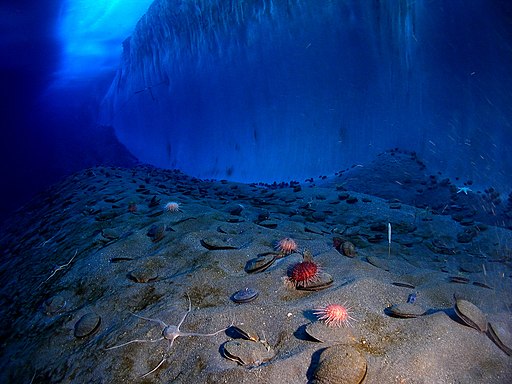These grains include what looks like a tiny crustacean's claw, a minuscule shell, and spines possibly from a sea urchin. Image from Nikon Small World.
Thursday, January 26, 2012
Friday, January 20, 2012
Siphusauctum
Over a century after its initial discovery, the Burgess Shale continues to be a treasure trove of bizarre Cambrian fossils, most recently this tulip-shaped creature:
 |
| Reconstruction by Marianne Collins |
“Most interesting is that this feeding system appears to be unique among animals. Recent advances have linked many bizarre Burgess Shale animals as primitive members of many animal groups that are found today, but Siphusauctum defies this trend. We do not know where it fits in relation to other organisms,” said lead author O’Brien.Via Life Before the Dinosaurs.
Tuesday, January 17, 2012
Fossils from Darwin's cabinet
A "treasure trove" of fossils - including some collected by Charles Darwin - has been re-discovered in an old cabinet.From BBC News. The Daily Mail has more pictures.
The fossils, lost for some 165 years, were found by chance in the vaults of the British Geological Survey HQ near Keyworth, UK.
...
The find was made by the palaeontologist Dr Howard Falcon-Lang.
Dr Falcon-Lang, who is based in the department of earth sciences at Royal Holloway, University of London, spotted some drawers in a cabinet marked "unregistered fossil plants".
"Inside the drawer were hundreds of beautiful glass slides made by polishing fossil plants into thin translucent sheets," Dr Falcon-Lang explained.
"This process allows them to be studied under the microscope. Almost the first slide I picked up was labelled 'C. Darwin Esq'."
Sunday, January 15, 2012
McMurdo Sound, Antarctica
This image of an ice wall and the ocean floor at Explorer's Cover, New Harbor, McMurdo Sound is adjacent to remote-controlled photographic equipment. An underwater camera is connected by cable to onshore facilities, which upload images to the Internet via radio signals.
Friday, January 13, 2012
"Fungi which grow Horizontally..."
John Hill, 1714?-1775.
A general natural history: or, New and
accurate descriptions of the animals, vegetables, and minerals, of the
different parts of the world. .
3 v. London: Printed for Thomas Osborne, 1748-1752. 72[?], plate 4.
Image source. Wednesday, January 11, 2012
X-ray seahorses
circa 1910: An X-ray photograph of pot bellied seahorses (Hippocampus abdominalis).
From a LIFE gallery of x-rays.
Monday, January 9, 2012
Planktonic protists
The word "plankton" shares a Greek root with "planet" (πλαγκτός,
meaning drifting or wandering)-- an etymological link which seems
particularly appropriate for these drifting microbes, spherical or
stellate in form:
This beautiful clip is one of a series called Plankton Chronicles, found via The Book of Barely Imagined Beings.
This beautiful clip is one of a series called Plankton Chronicles, found via The Book of Barely Imagined Beings.
Friday, January 6, 2012
Sponges and their skeletons
Images of sea sponges from the Report on the Hexactinellida collected by H.M.S. Challenger during the Years1873-76; each image shows a sponge framed by examples of the glass-like spines (called spicules) which make up its "skeleton":
Sea cucumbers also have attractive mineralized parts called spicules, but these function as external armor rather than internal support. Wednesday, January 4, 2012
Subscribe to:
Posts (Atom)









